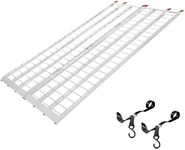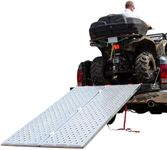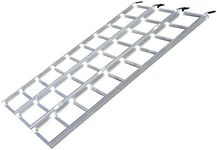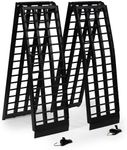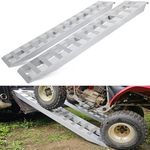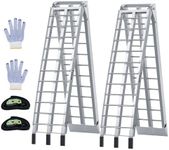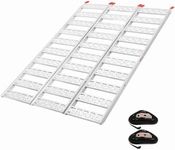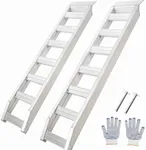Buying Guide for the Best Atv Loading Ramps
When choosing ATV loading ramps, it's important to consider several key specifications to ensure you select the right product for your needs. The right ramp will make loading and unloading your ATV safe and efficient. Here are the key specs you should focus on and how to navigate them to find the best fit for you.Weight CapacityWeight capacity refers to the maximum weight the ramp can safely support. This is crucial because using a ramp that cannot handle the weight of your ATV can lead to accidents and damage. Weight capacities typically range from 500 to 3,000 pounds. If you have a lightweight ATV, a ramp with a lower weight capacity might suffice. However, for heavier ATVs or if you plan to use the ramp for other heavy equipment, opt for a higher weight capacity to ensure safety and durability.
Ramp LengthRamp length is the measurement from the base to the top of the ramp. This is important because a longer ramp will provide a gentler incline, making it easier and safer to load and unload your ATV. Ramp lengths can vary from 6 to 12 feet or more. If you have a higher truck bed or trailer, a longer ramp is advisable to reduce the steepness of the incline. For lower vehicles, a shorter ramp may be sufficient. Consider the height of your loading surface and choose a ramp length that provides a manageable incline.
Ramp WidthRamp width is the measurement across the ramp's surface. This is important to ensure that your ATV fits comfortably on the ramp without the risk of slipping off. Ramp widths can range from 10 to 20 inches or more. If you have a wider ATV, look for ramps with a greater width to accommodate the vehicle's tires. For narrower ATVs, a standard width may be adequate. Always measure your ATV's tire width and compare it to the ramp's width to ensure a proper fit.
MaterialThe material of the ramp affects its durability, weight, and ease of use. Common materials include aluminum, steel, and composite. Aluminum ramps are lightweight and resistant to rust, making them easy to handle and long-lasting. Steel ramps are heavier but offer greater strength and durability. Composite ramps are a blend of materials designed to provide a balance of strength and weight. Choose a material based on your need for portability, strength, and resistance to the elements.
Folding DesignA folding design allows the ramp to be compacted for easier storage and transport. This is important if you have limited space or need to frequently move the ramp. Folding ramps can be bi-fold, tri-fold, or even multi-fold, depending on the design. If you need a ramp that is easy to store and transport, look for one with a folding design that suits your space constraints. Consider how often you will need to move the ramp and choose a design that offers the best balance of convenience and functionality.
Traction SurfaceThe traction surface of the ramp ensures that your ATV tires grip the ramp securely during loading and unloading. This is important to prevent slipping and accidents. Traction surfaces can include serrated rungs, rubberized coatings, or textured patterns. If you often load your ATV in wet or muddy conditions, look for a ramp with a high-traction surface to ensure safety. For general use, a standard traction surface may be sufficient. Consider the typical conditions in which you will use the ramp and choose a surface that provides adequate grip.


